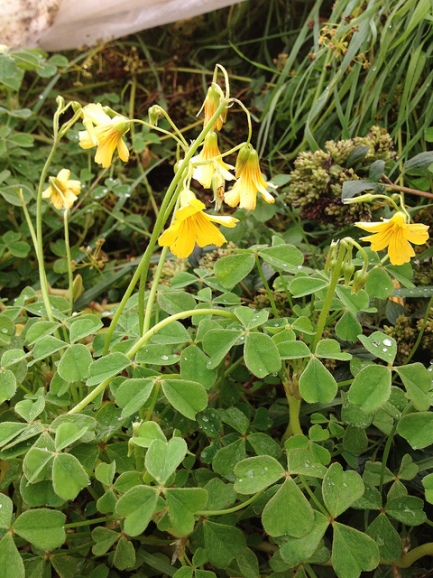 Family: Oxalidaceae
Family: Oxalidaceae
Genus: Oxalis
Species: Oxalis tuberosa
Common names: oca, uqa, New Zealand yam Swedish name: oca
The genus Oxalis got its name from the plants content of oxalic acid giving the leaves and flowers a sour taste. Several species are grown as container plants (indoors and outdoors) or as ornamental plants in gardens. Four common species are O. versicolor, O. compressa (double flowers), O. triangularis (dark purple foliage) and O. articulata. The flowers of the Oxalis genus range in color and shades from white to yellow, peach, pink, or multi-coloured flowers.
The fleshy, juicy tubers of Oxalis tuberosa are edible and called oca. The root vegetable is a native plant in the northern Andes and were grown by the Inca people. It is still grown by farmers in South America. Oca is an important vegetable locally due to its use in crop rotations and its high nutritional content. The tuber is a source of carbohydrate and energy. And has a valuable content of vitamin C, beta carotene, potassium and vitamin B6. It also contains small amounts of fibre. Oxalis tuberosa has a slow growth and gives less yield than potatoes so it is not common on other continents. Except for New Zealand where it was introduced in the 1800´s and became very popular. There oca often is called New Zealand yam. The tubers can be processed and prepared in various ways. The leaves and young shoots can be eaten as a green vegetable.

Oxalis tuberosa. Photo: mpaola_andreoni ©
Description: Oxalis tuberosa is a perennial herbaceous plant that overwinter as underground stem tubers. Several varieties are now available in yellow, orange, apricot, pink, as well as the traditional red-orange tubers.
How to grow: Oxalis tuberosa can be kind of tricky to grow because of its dependents of day length to grow properly. If it is to be grown as an ornamental plant other Oxalis species are preferable. Oca needs a long growing season, forming tubers when the day length shortens in autumn. In areas with harsh winter climates, early frosts may cut back the foliage before the tubers have a chance to form. In tropical areas where the days are unchanging in length, oca will not set a crop successfully. But it is quite modest in other requirements and generally grows even in marginal soil quality. Oxalis tuberosa is propagated vegetatively by planting whole tubers.

Oca or New Zealand yam. Photo: Lamerie ©
Oca or New Zealand Yam Recipes
Warm Oca Salad – recipe by Carl Legge at Permaculture
Roast Yams – recipe by CheekyKiwi at Allrecipes
Oca Homity Pie – recipe by Carl Legge at Permaculture
And for those of you who would like to try growing oca visit Growing Oca a blog by Ian Pearson.
© The photos are licensed by Creative Commons and some rights are reserved. License Attribution 2.0
Shared at:



Wow, thats an impressive looking giant of a tree – gorgeous – love how the flowers looks like they are falling down… Lovely:-)
LikeLiked by 1 person
Thank you!
LikeLike
An interesting species – the tuber, leaves and young shoots are all edible. The flowers are very pretty too. Will be an excellent plant in a garden.
LikeLike
Thank you!
LikeLike
I only know oxalis as an annoying weed that is really hard to get rid of… I had no idea you could eat them.
LikeLike
I guess some species can be weed-like…
LikeLike
I learn something each time I read your blog!
Yvonne
PS — Thank you for your kind comments on my post.
LikeLiked by 1 person
Thank you Yvonne! I love to read your posts – it is my pleasure to comment.
LikeLike
We call them yams and eat them more often in winter than summer. (I live in New Zealand).
LikeLiked by 1 person
Thank you contributing with this insight. It is always great with information straight from the source 🙂
LikeLike